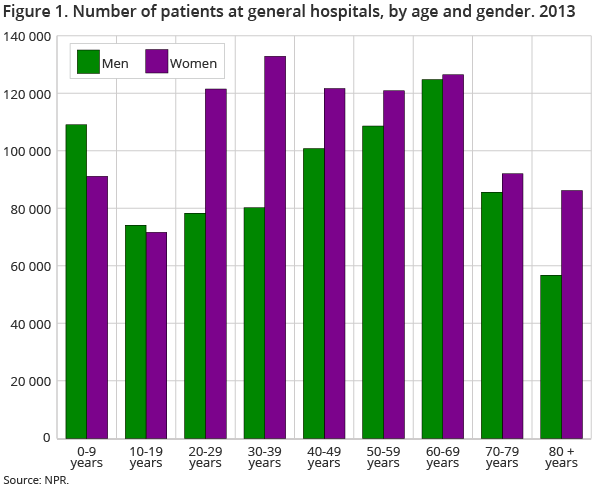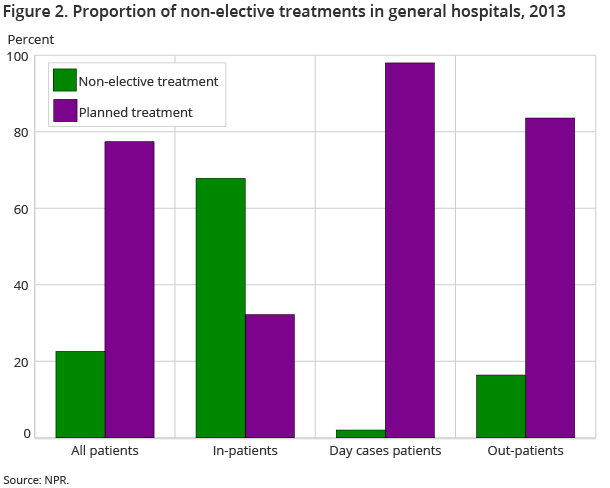Content
Published:
This is an archived release.
One in three consulted general hospitals in 2013
Almost 1.8 million patients were treated or examined at general hospitals in 2013. Most were treated as out-patients, and the most common cause of treatment was injuries.
| In total | Men | Women | |
|---|---|---|---|
| 1One person can have received treatment at more than one level of care. Only Norwegian residents are included. | |||
| Total number of patients at general hospitals | 1 782 227 | 818 033 | 964 194 |
| In-patients | 577 335 | 255 631 | 321 704 |
| Number of patients with day cases | 206 937 | 90 446 | 116 491 |
| Out-patients | 1 581 705 | 721 405 | 860 300 |


One in three were treated in a hospital in 2013. This is a slight increase compared to 2012. About 1.5 million received treatment as outpatients, almost 600 000 as inpatients and 200 000 as day cases. The average length of stay for inpatients has declined from 5.2 days in 2004 to 4.0 days in 2013.
More women than men treated at general hospitals
Eighty-four per cent of the patients treated in hospitals (in all levels of care) were below 70 years of age. Among patients aged 20 years and older, more women than men were examined or treated in a hospital, as shown in Figure 1. Women use health services in connection with pregnancy and childbirth, and they live longer than men. Nearly 54 per cent of all patients are women. With regard to children and adolescents, 346 000 patients (20 per cent) were treated at hospitals in 2013, including 44 400 healthy new-borns.
Two out of three admitted for non-elective treatment
Two in three in-patients were admitted for non-elective treatment, as shown in figure 2. Non-elective admissions are prioritised. The numbers of non-elective admissions are highest in the eldest patient groups (81 per cent). There is also a significant percentage of non-elective admissions among patients between 20 to 39 years of age (73 per cent).
In-patient diagnoses
There were 114 per 1 000 inhabitants who had a disorder that caused hospitalisation. Injuries, cardiovascular disease, pregnancy, childbirth and conditions in the postpartum period and diseases of the respiratory system and cancer were the most common reasons for patients being admitted for an in-patient stay. There were 884 000 in-patient stays; an average of 1.5 stays per patient in 2013.
Older people who have been hospitalised have on average more in-patient stays and more bed-days than younger people. For men aged 80 years and over, the figure was 377 per 1 000 inhabitants, and the corresponding figure for women was 326.
Large numbers to hospital with injuries
Nearly 302 000 patients were treated for injuries and poisoning in general hospitals in 2013. Most were hospitalised for injuries and only a small number of patients were treated for poisoning; almost 6 000 patients.
Among patients with injuries and poisonings, there were more men than women. Most were treated as out-patients: 249 000 patients. Nearly 78 500 patients had in-patient stays and only 12 700 were treated as day cases. (A patient may have received treatment at more than one level of care.)
Boys and older women treated for injuries
Injuries were a common cause of admission among children and adolescents aged 10-19 years, with 51 600 patients. More boys than girls were admitted for injuries (56 per cent boys). We find the highest number of admissions for injuries among the elderly aged 80 years and over; 119 patients per 1 000 inhabitants, and highest among elderly women with 131 per 1 000.
The corresponding figure for the age group 10-19 years was 81 patients per 1 000 inhabitants. Among children aged 0-9 years, there were fewer injuries per capita than in the average population. However, injuries were still the most common reason for contact with the hospital.
Arm injuries common
Nearly 108 000 patients were treated for arm injuries, in all levels of care. There were also other types of injuries, such as concussion and internal head injuries for about 15 700 patients. Fracture of the femur usually means admission and an in-patient stay (10 500 patients). Older women are affected more frequently than men, with 34 patients in in-patient stays per 1 000 inhabitants and 20 patients per 1 000 inhabitants for males.
Elderly patients receive in-patient care far more often than younger people. Per 1 000 inhabitants, there were 12 patients aged 10-19 years admitted to hospital for injuries, and the corresponding figure was 69 for the elderly aged 80 years and over. In the out-patient clinic there were slightly more young patients; 73 vs. 68 per 1 000 inhabitants for the elderly.
Differences from the Norwegian Patient Register Open and readClose
The patient statistics from Statistics Norway are based on data from the Norwegian Directorate of Health’s Norwegian Patient Register (NPR). The population for the patient statistics in Statistics Norway covers the activity in general hospitals according to the definition in the Register of Business Enterprises. This definition deviates somewhat from the population that the NPR uses in its statistics, which covers all institutions with activity-based financing.
Patients living abroad are not included Open and readClose
Patients treated in Norway, but living abroad are not included in the statistics. There were 10 300 foreign patients receiving care in 2013. They had 4 977 hospital stays, 483 day cases and 8 818 out-patient consultations.
Contact
-
Geir Hjemås
E-mail: geir.hjemas@ssb.no
tel.: (+47) 93 08 27 75
-
Elin Skretting Lunde
E-mail: elin.skretting.lunde@ssb.no
tel.: (+47) 92 42 70 07
